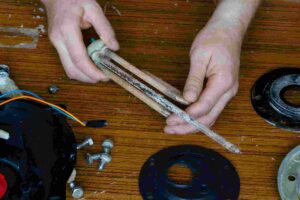How to Replace a Water Heater Anode Rod Easily
Water heaters are important home appliances, but they can break down faster than thought if they aren’t taken care of properly. The anode rod is one of the most important parts that people often forget about. If you’ve been noticing dirty water, bad smells, or less efficient heating, it may be time to change the anode rod in your water heater. This step-by-step guide tells you everything you need to know.
Why the Anode Rod Matters
It’s a metal stick that’s inside your water. Heater’s tank that is used as a sacrifice. It is usually made of magnesium, aluminum, or zinc. Its main job is to pull in minerals that are bad for the water which keeps the steel tank from rotting. The rod wears out over time and needs to be replaced to make the heater last longer.

Benefits of Replacing the Anode Rod
- Keeps the inside of the tank from rusting and damage.
- Reduces the taste and smell of metal in water, which makes the water better.
- Makes your water heater last years longer.
To keep your heater in great shape, you can also read tips like “How to Flush a Water Heater.”
Signs You Need to Replace the Anode Rod
- rusty or cloudy water coming out of the faucets.
- Rotten egg smell (caused by sulfur bacteria reacting with a depleted rod).
- Loud popping or rumbling sounds from sediment buildup.
- The rod looks thin, coated, or almost dissolved when inspected.
- The rods in your water heater haven’t been changed in more than three to five years.
Tools and Materials You’ll Need
Before you change the water heater’s anode rod, make sure you have these things:
- A tool or a breaker bar
- Tape that doesn’t stick
- Garden hose (to get rid of water)
- New anode rod (check the heater’s instructions to see what kind and what size it is)
- Plumber’s tape or pipe dope
- Safety glasses and gloves
Replacing the Anode Rod
Turn Off Power and Water Supply
- Cut the power to the water heater if it’s electric.
- For gas water heaters, turn the gas knob to “Pilot.”
- Close the hole that lets cold water in.
Get rid of some water
- Connect a line to the drain valve on the tank.
- Drain out a few gallons of water (enough to lower the level below the rod’s position).
Locate the Anode Rod
- Most rods are found under a hex head fitting on top of the tank.
- You can connect them to the hot water outlet on some types.
Remove the Old Anode Rod
- To loosen it use a socket wrench and some strength.
- If it’s really stuck, use penetrating oil or a breaker bar to get it free.
Put the new rod in.
- Put Teflon tape on both ends of the new rod.
- Before you put it in the tank make sure it’s tight.
Refill and Restart
- Turn on the cold water and let the tank fill up.
- Turn on the gas or electricity to the heater again.
- To get rid of trapped air open a hot water faucet.
Types of Anode Rods
- Magnesium rods – Best for soft water, offer strong protection.
- Aluminum rods – Good for places with hard water.
- Zinc-aluminum rods – The smell of rotten eggs goes away quickly.
- Powered anode rods – For long-term safety, use energy instead of metal as a sacrifice.

Maintenance Tips After Replacement
- Check the rod every two to three years.
- Keep the tank clean (see Tankless Water Heater Flush).
- To keep the air from going down, check other parts like the Water Heater Expansion Tank.
- See Gas Water Heater Repair if you find leaks or other problems with gas.
Common Mistakes to Avoid
- Forgetting to turn off the gas or electricity before starting.
- Not letting enough water run, which leads to spills.
- Not having the right rod type or size.
- Cross-threading the new rod during installation.
- Ignoring other maintenance needs like flushing and descaling.
Cost of Replacing an Anode Rod
- DIY replacement: $20 to $50 (for the stick alone).
- Professional service: $100 to $300 (for work and parts).
- Compare this to a full water heater installation cost which can run into hundreds or even thousands.
It’s clear that proactive replacement is the better option.
Conclusion
Getting a new anode rod for your water heater is an easy but effective way to keep it in good shape and make it last twice as long. You can avoid rust, save money, and have clean hot water for years if you know what you’re doing and have the right tools. Check and replace your anode rod often, rather than waiting until your tank breaks.
Frequently Asked Questions (FAQs)
Q1. How often should I replace the anode rod in a water heater?
Most experts say that you should change your water heater’s anode rod every three to five years, based on the quality of your water. If you live in a place with hard water, you might need to check it more often.
Q2. What will happen if I don’t change the anode rod?
If you let the rod rust all the way through. In the end, this can cause leaks, bad smells, and the need for an expensive repair.
Q3. How do I know what type of anode rod to buy?
Open the instructions for your water heater. Magnesium, aluminum, and zinc-aluminum bars are all common choices. To keep their homes safe for a long time, some people put in powered anode rods.
Q4.Should I call a professional or can I change the anode rod myself?
If you know how to work with pipes, you can change it yourself with some simple tools. Call a plumber if the rod gets stuck or if you’re not sure about safety.
Q5. Will replacing the anode rod fix smelly water?
Yes, in many cases. A zinc-aluminum rod is often recommended for solving the rotten egg smell caused by sulfur bacteria.